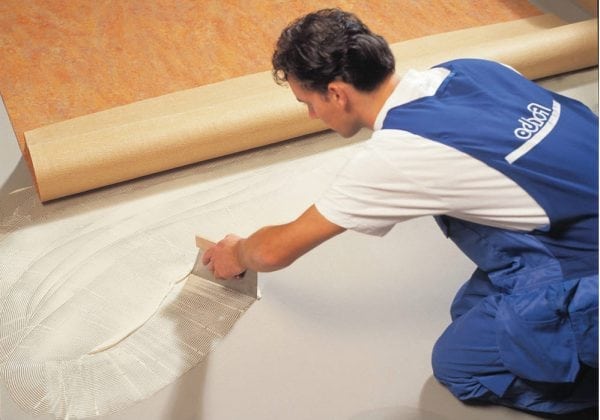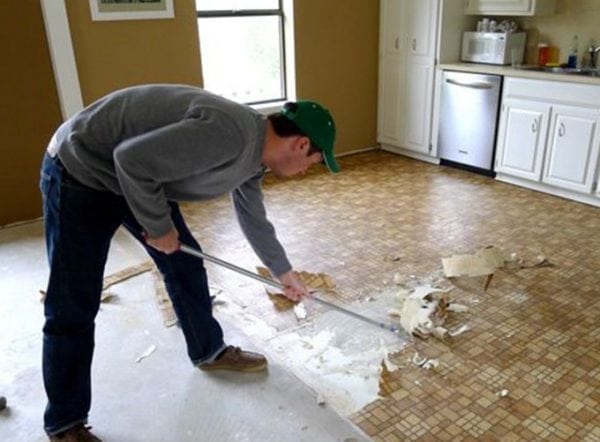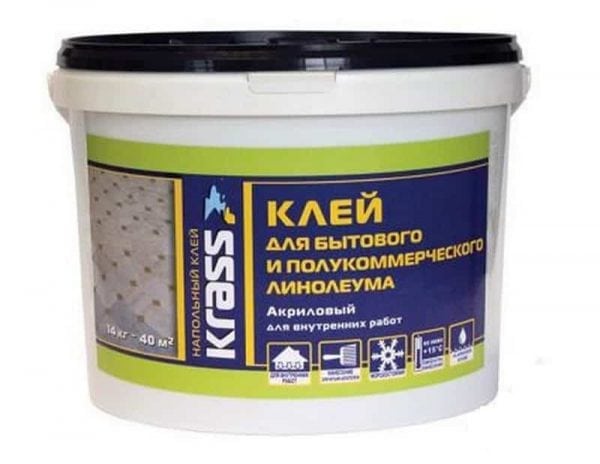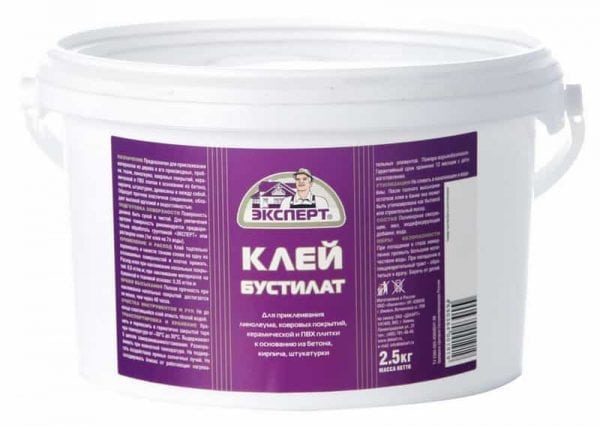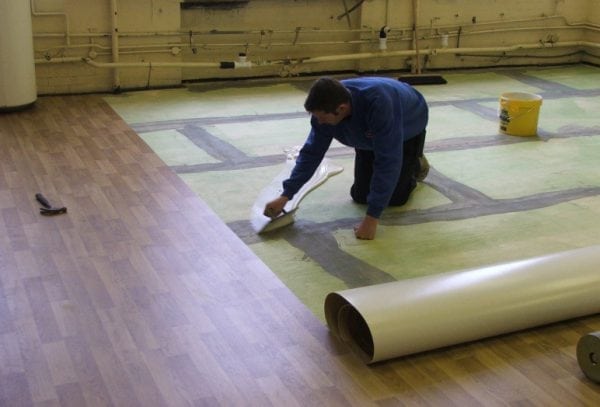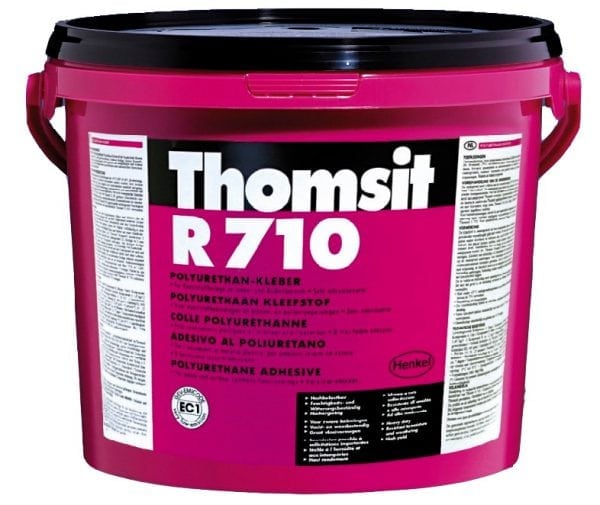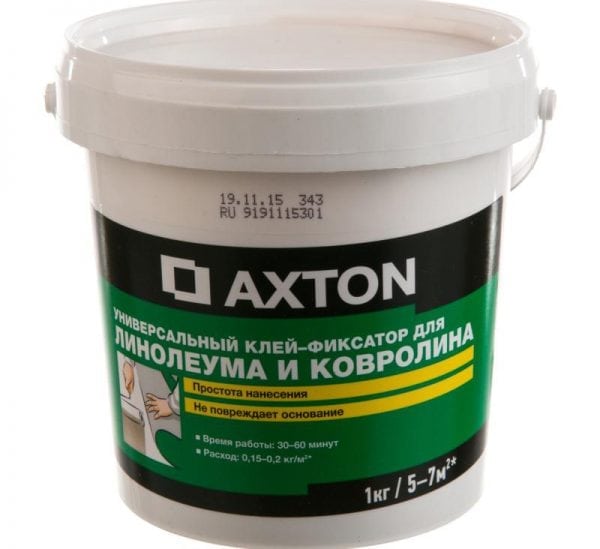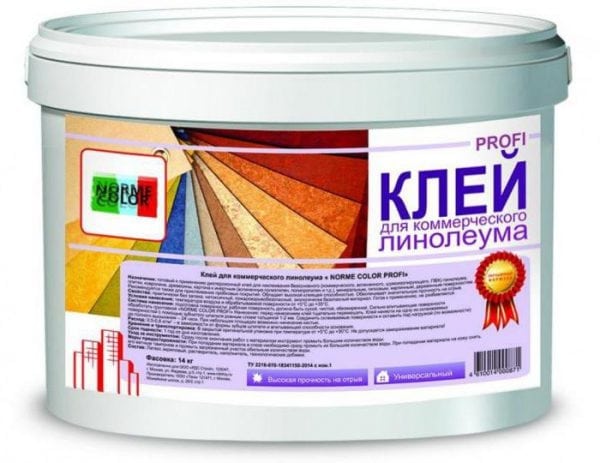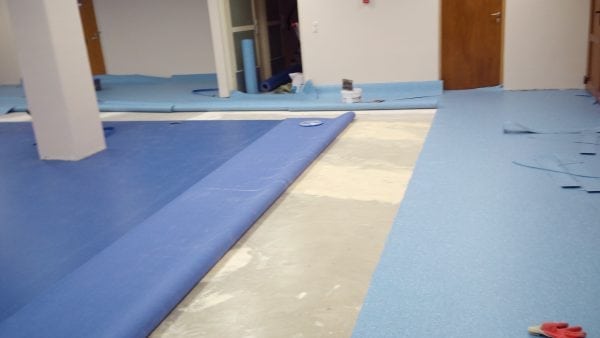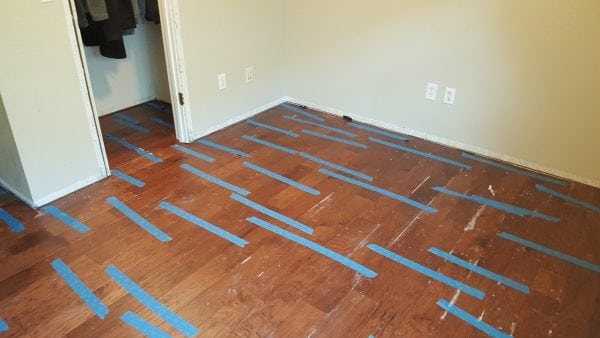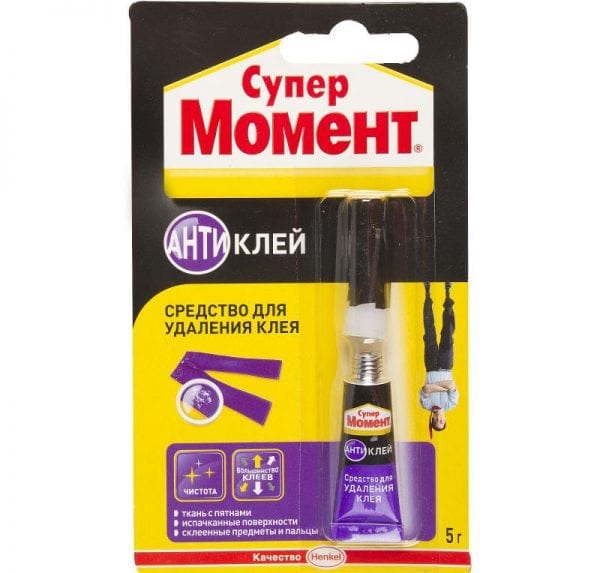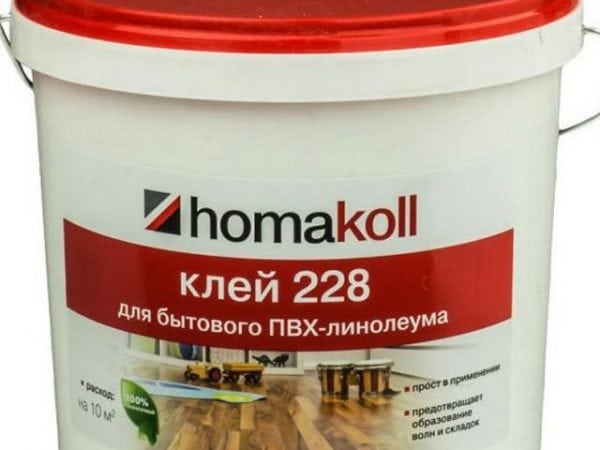Laying linoleum is the easiest option for creating a beautiful floor covering with your own hands. There is a misconception that the canvas can simply be thrown to the floor. In fact, to do the job efficiently, linoleum glue is indispensable. Unless the material is self-adhesive. It is worth familiarizing yourself with the types of adhesives and the correct technique for sticking coatings.
- Advantages and disadvantages of gluing linoleum
- Types and characteristics of glue
- Dispersion Adhesives
- The reaction compounds
- Glue brands for linoleum
- Glue selection
- Bonding linoleum to concrete floor
- Sticking on wood flooring
- Removing glue from linoleum
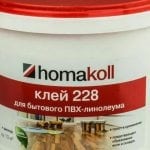
Advantages and disadvantages of gluing linoleum
Why do professionals prefer to lay carpets or linoleum with glue? This installation method is ideally suited for rooms with an area of more than 10-15 square meters, where often you have to have several joined strips. It must be glued if it is necessary to fix individual pieces, for example, to change part of the deteriorated coating.
The advantages of the sticker are as follows:
- Even in a small room, a free-standing linoleum can eventually bubble, become deformed. Gluing will increase the contact area of the flooring with the base and will not allow the waves to go.
- The use of special adhesive means reduces the risk of dimples from furniture legs. Also, when sofas, wardrobes and beds move along the floor, the risk of displacement of the cover is significantly reduced.
- Without glue, gaps appear at the joints, and the edge of the linoleum sticks out ugly, twists, water gets under it while washing the floor. The use of an adhesive composition eliminates this problem.
- The durability of a securely attached flooring increases by 20-40%, which is especially true for thin materials that are prone to damage and tearing. Adhesive helps reduce the incidence of microcracks.
- Tightly glued coating better protects against water leakage in an emergency, prevents mold and mildew from multiplying. If linoleum is laid on a wooden floor, the base material will not rot.
Disadvantages of this installation technology are present, but they are few. Means of the economy series are not very reliable, and high-quality adhesives are not cheap. Therefore, the price of repairs can increase significantly. Also disadvantages include the following:
- increase in time for repairing the room by 1-3 days;
- increasing the complexity of work;
- the difficulty of tearing linoleum from the floor (if you need to re-glue it);
- the impossibility of re-applying the coating - when dismantled, it is torn in pieces.
to contents ↑If you are not an expert in the question of which glue to choose, there is a risk of acquiring a composition that negatively affects the environment, harmful to humans. The chemical ingredients of the glue improve adhesion and other beneficial properties, but adversely affect the body.
Types and characteristics of glue
How to glue linoleum to the floor? On sale there are two main types of adhesives - dispersion and reaction. The choice depends on the characteristics of the coating and the surface on which it is laid.
Dispersion Adhesives
All products of this type are aqueous emulsions of polymer resins with the addition of various fillers, mineral particles. The benefits are obvious. Facilities:
- have no unpleasant smell;
- elastic;
- thanks to a water base non-toxic, environmentally friendly;
- have excellent adhesion to the base.
Means are suitable for gluing linoleum on a concrete floor. After solidification, they are not exposed to moisture, perfectly seal joints and seams. The price is low: for example, the popular Homakoll glue costs 200-250 rubles / kilogram. Consumption per 1 square. m is minimal, while many adhesives are frost-resistant.
Dispersion agents are divided into several groups:
- acrylate with acrylic resins are suitable for fastening to wood, concrete, a base of mineral materials of semi-commercial and commercial linoleum;
- polyvinyl acetate, bustilates with the addition of latex, chalk are suitable for gluing a thick PVC coating on a felt basis to fiberboard, particleboard, concrete;
- Gumilax-type compounds based on rubber and latex resins are suitable for homogeneous material or foamed household coating on a natural basis;
- conductive adhesives with dispersion of conductive powder are used when laying antistatic linoleum;
- rubber mastics with bituminous resin are used for flooring on the first floors, in damp rooms. The rest are suitable only for rooms with humidity up to 55-60%.
Many dispersion adhesives can not be used at low temperatures, so for a balcony, summer kitchen or other similar premises it is better to purchase a composition marked with frost resistance. It will not crumble even when freezing. When buying, it is necessary to clarify the indication of GOST, check the certificates of conformity and the release date. Expired adhesives partially lose their properties.
to contents ↑The reaction compounds
How to glue the coating securely in difficult areas? For this purpose, use reaction adhesives, such as universal and carpet. They are called "cold welding" and are used to weld seams and joints.
The components of the composition react with the material. After polymerization, a rigid, moisture-resistant layer is formed between the base and the floor, tear-resistant and shear-resistant. The bonding strength is very high, the junction withstands shock loads, vibration.
Adhesives are one-component and two-component, the latter must be mixed before use.
Scope of use of reaction glues:
- Offices and other commercial premises;
- rooms with high traffic - living rooms, halls, kitchens;
- Bathrooms
- balconies;
- stairs, common corridors.
All adhesives can be divided into two groups depending on the composition:
- Polyurethane Suitable for any type of linoleum, to all known reasons. They are often used in residential premises, as the unpleasant odor is weak and quickly disappears. The cost is high - from 400-500 rubles per kilogram.
- Epoxy Consist of epoxy resin and hardener (two-component). Their strength is even higher, but in the composition there are toxic components (solvents). Typically, such adhesives are used for outdoor applications. Price - from 600 rubles per kilogram.
In most reaction adhesives, the adhesion rate when used on a dirty floor is seriously reduced. Therefore, before work, it should be thoroughly washed. Mineral substrates need a primer coat - this will reduce adhesive consumption and improve adhesion. The disadvantages of adhesives include their rapid flammability - installation must be done with great care.
to contents ↑Glue brands for linoleum
In construction stores, funds from various manufacturers are sold. The most popular in practice are Ceresit, Thomsit, Homakoll, Titan and others. Below is a list of tools that are suitable for gluing linoleum:
- "Expert Bustilat." Suitable for fixing linoleum on plywood, concrete, wood, it is better to use it on PVC coatings on a felt or jute basis. Drying time is 24 hours.
- PVA is universal. Includes latex, suitable for gluing different materials on the floor and wall, suitable for felt linoleum. Low consumption - up to 250 g / square meter for continuous application.
- Glue KS universal.At the core is liquid sodium glass, therefore it is more often used when laying ceramic tiles. Suitable for linoleum on a fabric, felt, jute basis.
- "Polynomial 105". Acrylic glue, can be applied to all types of materials and substrates, the drying time is short - 12 hours.
- Homakoll 228. This is a water-dispersion adhesive for any household linoleum (homogeneous, heterogeneous). They can glue material on a foam, pile, fabric basis. The product is solvent free and low in water. Homakoll 228 analogues are Homakoll 208, 202 and 248. Their properties are similar, but they are used only in rooms with low humidity.
- Thomsit L 240 D. Suitable for coatings with a thickness of less than 2.5 mm on water-absorbing substrates. It is applied in hospitals, schools.
- Forbo Eurocol Super 599. Forbo glue universal, average viscosity. Ideal for soft roll coatings. Its variety - Forbo Erfurt 523 with antistatic properties prevents the appearance of stray currents.
- Bostik KS 330. Dispersion glue, does not contain harmful components. It can be used for installation of a heat-insulated floor.
- Linocol - "cold welding". It is used mainly for fixing joints of flooring. Easily fastens seams up to 4 mm thick. Easy to use thanks to a thin nose.
- Mapei Ultrabond Eco Contact. For PVC coatings, solvent free. Adhesion at a very high level will help to stick linoleum on stairs and walls.
- Glue 88 rubber. Known composition, considered universal in everyday life. It is best used for gluing joints. It slightly melts the base, but does not corrode it, which ensures good adhesion. It is realized in the form of "liquid nails" in banks and tubes.
- Sintex H44. "Cold welding" for commercial, semi-commercial, household linoleum. Prevents shrinkage, creates a durable seam. If the surface is wet during operation, the seam will turn white.
- Axton is universal. Suitable for linoleum, carpet. It is sold in cans of 14 kg, is applied with a spatula, and has high frost resistance.
- Kiilto Uki. High strength composition, while environmentally friendly, odorless. They can stick PVC coatings and plates, carpets, materials with a cellular-cellular backing.
- Forbo 522. Dispersion glue, resistant to the migration of plasticizers, is best suited for foamed vinyl.
- Titan Wild. It is widely used in repair work, it can be applied to any floor covering. When thickened, it is easily diluted with alcohol.
- VGT floor "House-keeper". Suitable for household linoleum, carpet, waterproof, elastic, can withstand freezing.
- Werner Muller adhesives. Various types of cold welding products are available for new and old coatings, synthetics and flooring on a natural basis. It is used only in dry rooms.
Separately, Tarkett brand adhesives should be noted. The manufacturer also produces flooring, so it knows a lot about the means for their installation. Compounds for natural canvases with antistatic properties and for a single-layer (homogeneous) material are sold. Adhesives for commercial and semi-commercial coatings are sold separately.
to contents ↑Glue selection
It is necessary to select a tool not only depending on the type of coating. Be sure to consider the type of base. Some adhesives are universal, others can not glue the flooring with wood (plywood, board). If you want to save money when connecting flooring with a wooden floor, you can buy PVA.
It is more difficult with a concrete screed - you will have to acquire a professional composition. Having met a popular brand on the counter, you must carefully read the instructions. It always indicates what the glue is suitable for. Next, a calculator is useful to calculate the consumption of materials and, accordingly, the cost of repair and choose a means affordable.
to contents ↑Bonding linoleum to concrete floor
Concrete substrates include those in which cement was used. They are able to retract and retain liquid materials. If linoleum fits "forever", this property will come in handy, but if you need regular updating of the coating, this property will be harmful.Therefore, such requirements are imposed on compositions for gluing coatings on concrete. They have to:
- allow, if necessary, to remove material;
- hold firmly, prevent linoleum from shifting during operation;
- Do not destroy the coating, do not flush modifying additives from it.
It is best to buy linoleums with fabric insulation, alkyd (glyphthalic) for concrete floors. If you purchased a flooring without a base, for its installation you will have to lay a layer of fiberboard, chipboard, OSB.
How to glue linoleum on concrete? Here is a step-by-step instruction:
- Thoroughly prepare the base - clean from dust, dirt, stains, dry, remove the baseboard. If cracks are more than 2 mm deep, they must be repaired with a building mixture. Temperature during work - not lower than +15 degrees. Leave the purchased material in a warm room for 2 days without rolling the roll.
- Drill holes for baseboards and door sill, if necessary. Make a trim around the perimeter of the canvas. If linoleum is put in a single piece, uneven edges will be covered with a plinth. A gap of 0.5 cm must be left between the wall and the web.
- Prime the concrete floor with a composition that is suitable for this purpose and does not contradict the components of the adhesive. Typically, compatibility is reflected on the packaging of the products. Some experts also primed the inside of linoleum, but this is not necessary.
- Then you can proceed with the installation of the coating. Bend half of the linoleum, using a spatula, apply glue with a thin layer. When it is indicated that the composition can be applied with a net, they do so. This is usually permitted only in small rooms. Then, if indicated in the instructions, wait until the glue dries slightly.
- Press the cover to the floor, smooth. To do this, it is best to use a construction roller (“rolling pin”). Drive out all the accumulations of air, moving from the center to the edges. Do the same with the second half of the cover. Make an edge under the door jamb. Do not walk on the floor for 1-2 days.
In large rooms, two or more pieces of material have to be glued. The technology is the same, but glue is not applied to the edges (15 cm), the sheets are overlapped by 3 cm.The joint line is cut along two sheets at once, having drawn an even strip and pressed it with a metal ruler or temporarily fixed with double-sided tape. This work is carried out after the glue has completely dried. Then, bending the edges, glue them with compounds of the type of "cold welding". After they press and roll the junction with a rubber roller, remove excess glue. Apply the load, leave for 2 days. After you can set the sills.
to contents ↑Sticking on wood flooring
General requirements for wooden floors are as follows: the base must be clean, dry, even. If there are gaps between boards or sheets, they must be puttied. A roll of linoleum is left in the room for 2 days to be aged at room temperature. To work, you need to prepare:
- glue;
- roulette wheel;
- putty knife;
- rubber roller or clamp;
- sharp knife;
- marker.
Linoleum is recommended to be purchased strictly according to the size of the room - this will avoid joints, seams. Before gluing, trim along the perimeter, taking into account the architectural features of the room. At the same time, the cut-off part is held so that the coating does not tear, and a board is placed under the bottom. Pre-glued to plywood, OSB, boards, double-sided tape at a distance of 40 cm from each wall. This will help to avoid slipping the coating when cutting. After a day, you can start gluing. Roll the roll before work.
The procedure is almost the same as with a concrete base, but has the features:
- at the edge of the roll, grease the wooden floor with glue - a strip 30 cm wide, while it is advisable to make the layer uniform in thickness, without tubercles and furrows;
- attach the material to the plastered place, act accurately, since repeated rolling reduces the quality of bonding;
- go to the spread out area, remove the air from under the linoleum with a flat clamp;
- inspect the surface of the material from different angles to completely eliminate the presence of bubbles;
- strip the whole room in strips of 30-40 cm, rolling the roll;
- after the composition has hardened, it is possible to glue the joints with the help of "cold welding" or another method, then fix the skirtings.
to contents ↑
Removing glue from linoleum
Often when repairing glue gets on the surface of the canvas. Wiping it in a dried form is usually not easy, so it is important to get rid of the stain before solidification. Fresh glue is easiest to remove with soapy water. A little liquid soap is added to warm water or soap chips are dissolved. Wipe the floor with a soft sponge. For the same purpose, kerosene is often used.
If the glue is dry, more aggressive products will have to be used. But many of them leave spots on the surface and spoil the material. It is recommended that you first try on an inconspicuous area of the floor - for example, in a corner, near the baseboard. It is best to use gasoline, kerosene, in extreme cases - white spirit. Acetone is strictly not recommended! Work must be carried out in a respirator and gloves, then thoroughly wash the floor with soap and water.
Removing superglue from the coating is even more difficult. You need to buy a special tool designed to clean the glue - “Moment Antikley”, “Contact”. In their absence, use gasoline. The composition is applied for 5-10 minutes, then wiped with a cloth. The softened spot is also carefully scrubbed off with a hard spatula. Due to the risk of damage to the material, it is better to be careful when sticking the coating, this will help to avoid problems.

